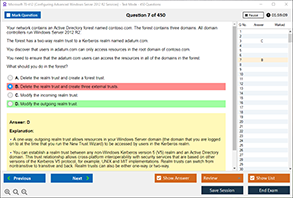Overview of Cisco 200-301 CCNA Exam
The Cisco 200-301 CCNA (Cisco Certified Network Associate) certification exam is a foundational credential for networking professionals. It validates the knowledge and skills needed to install, configure, and troubleshoot networks. Covering a wide range of networking topics such as network fundamentals, network access, IP connectivity, IP services, security fundamentals, and automation and programmability, the exam serves as a stepping stone for more advanced Cisco certifications and networking careers.
One crucial topic tested in the CCNA exam is the Open Shortest Path First (OSPF) protocol, a widely used interior gateway protocol (IGP) based on the link-state routing algorithm. Understanding OSPF and its essential elements, including the Router ID (RID), is vital for passing the CCNA exam.
DumpsBoss provides expertly curated exam dumps, practice tests, and study guides tailored to the Cisco 200-301 syllabus. With updated content reflecting the latest exam trends, DumpsBoss helps candidates gain deep knowledge and build the confidence needed to succeed.
Definition of OSPF (Link-State Routing Protocol)
OSPF, or Open Shortest Path First, is a dynamic routing protocol used within large enterprise networks. Unlike distance-vector protocols (like RIP), which send entire routing tables at regular intervals, OSPF uses a link-state algorithm. Each OSPF router creates a map of the network and shares it with its neighbors. This approach allows for faster convergence, better scalability, and more efficient routing decisions.
Key features of OSPF include:
-
Hierarchical design with areas: Promotes efficient route summarization and isolation.
-
Support for Variable Length Subnet Masking (VLSM): Allows for flexible IP addressing.
-
Authentication options: Enhances routing protocol security.
-
Faster convergence: Ensures quick adaptation to network topology changes.
Understanding OSPF and its internal workings is critical for network engineers, especially those preparing for the Cisco 200-301 exam.
What is a Router ID?
The Router ID (RID) is a unique 32-bit identifier used by OSPF to distinguish each router within an OSPF domain. It functions similarly to a name or a unique signature that allows routers to identify each other and form OSPF neighbor relationships.
The Router ID:
-
Must be unique within the OSPF network.
-
Is represented in dotted decimal notation (similar to IPv4 addresses).
-
Is not tied to any physical interface but is required for OSPF operations.
-
Is used in the OSPF database and LSAs (Link-State Advertisements).
The Router ID plays a central role in OSPF operations, influencing router elections (e.g., Designated Router and Backup Designated Router) and ensuring stability in OSPF neighbor relationships.
Format of the Router ID
The Router ID is expressed in the same format as an IPv4 address: four decimal numbers separated by dots, each ranging from 0 to 255 (e.g., 192.168.1.1). Despite its format, the Router ID is not necessarily an IP address assigned to any of the router's interfaces.
For example:
-
Valid Router ID: 1.1.1.1
-
Valid Router ID: 192.0.2.1
While the Router ID must be unique, it doesn't have to be routable or reachable—its main function is identification within the OSPF topology.
How the Router ID is Selected
The OSPF Router ID can be manually configured or automatically selected by the router based on specific rules. Understanding this selection process is crucial for both network design and CCNA exam success.
OSPF selects the Router ID using the following order of precedence:
-
Manually Configured Router ID
-
If the administrator sets the Router ID using the command
router-id <ip-address>in OSPF configuration mode, this value takes precedence. -
This is the recommended method, especially in large networks, for ensuring predictable and stable Router IDs.
-
-
Highest IP Address on a Loopback Interface
-
If no manual RID is configured, the router checks for loopback interfaces.
-
Among all loopback interfaces, the router selects the one with the highest IP address.
-
Loopback interfaces are preferred because they are always up, providing stability.
-
-
Highest IP Address on an Active Physical Interface
-
If no loopback interfaces are found, the router selects the highest IP address on any of its active (up/up) physical interfaces.
-
This method is less stable, as physical interfaces may go down.
-
The Router ID remains in effect until the OSPF process is restarted or manually reset using the command clear ip ospf process. Therefore, changes to the RID require an OSPF process reset to take effect.
Example Scenario
Consider a router with the following configuration:
-
Loopback0: 10.10.10.1/32
-
Loopback1: 10.10.20.1/32
-
FastEthernet0/0: 192.168.1.1/24
-
FastEthernet0/1: 172.16.1.1/24
In this case:
-
No manual Router ID is configured.
-
The router has two loopback interfaces.
-
OSPF will select the highest IP address among the loopback interfaces.
Router ID = 10.10.20.1
Now, if Loopback interfaces were not present, the router would compare the FastEthernet interfaces and choose the higher of the two:
Router ID = 192.168.1.1
This selection logic highlights the importance of careful network design and understanding how OSPF operates under the hood.
Common Mistakes and Exam Tips
Preparing for the Cisco 200-301 exam requires attention to detail and awareness of common pitfalls related to OSPF and Router ID configuration. Here are a few common mistakes and corresponding tips:
-
Forgetting to Manually Set the Router ID:
-
Tip: Always set a manual Router ID in production environments for predictability.
-
-
Assuming the Router ID Changes Immediately:
-
Tip: Remember that changing the Router ID requires restarting the OSPF process.
-
-
Misunderstanding the Selection Order:
-
Tip: Memorize the selection order: Manual > Highest Loopback > Highest Physical.
-
-
Not Using Loopback Interfaces:
-
Tip: Use loopback interfaces in OSPF networks for stable and reliable Router IDs.
-
-
Incorrect Format of Router ID:
-
Tip: Ensure Router ID is entered in dotted decimal format, and avoid duplicate values.
-
DumpsBoss Advantage: DumpsBoss offers detailed CCNA exam dumps and realistic simulation questions that mirror the exam's format and difficulty. Their content includes Router ID selection scenarios, troubleshooting questions, and OSPF configuration labs. Practicing with DumpsBoss materials helps avoid these mistakes and boosts exam readiness.
Conclusion
Understanding OSPF and the concept of Router ID is critical for anyone pursuing the Cisco 200-301 CCNA certification. The Router ID is a foundational element in the OSPF protocol, influencing the establishment of neighbor relationships, the election of designated routers, and the overall stability of routing tables.
By mastering how the Router ID is selected and applied, candidates can confidently approach related questions in the exam and apply this knowledge in real-world network configurations.
DumpsBoss stands out as a trusted partner in CCNA exam preparation. With expertly crafted practice questions, accurate study materials, and real-world scenarios, DumpsBoss empowers candidates to succeed on their first attempt. Don’t just study hard—study smart with DumpsBoss and take the next step toward becoming a certified networking professional.
Special Discount: Offer Valid For Limited Time “Cisco 200-301 Dumps” Order Now!
Sample Questions for Cisco 200-301 Exam Dumps
Actual exam question from Cisco 200-301 Exam.
What is the format of the Router ID on an OSPF-enabled router?
A) Hexadecimal number
B) MAC address
C) 32-bit number in dotted decimal format
D) Binary number



